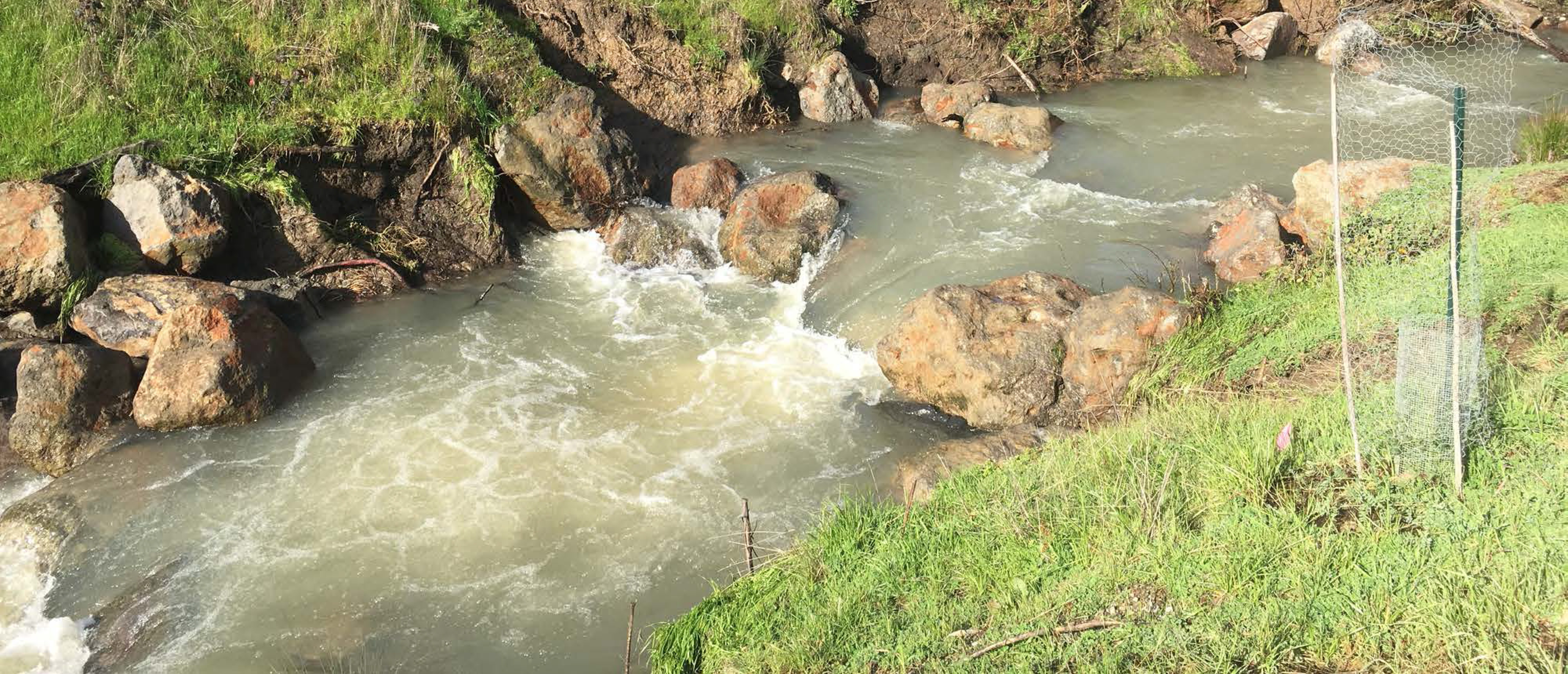
Purpose of the project: This project restored fish passage and stabilized the grade through a 600-ft stream reach of Upper Green Valley Creek (a tributary to the Russian River), resulting in passage for juvenile and adult coho salmon to an additional 4,810 ft (0.9 miles) of rearing and spawning habitat. The Green Valley Creek Watershed has a high potential for salmonid recovery, but sedimentation, channel incision, and fish passage barriers have limited the success of fisheries. This has been illustrated by a documented decline in fish habitat in the Upper Green Valley System by the California Department of Fish & Wildlife (CDFW) and accompanied by a collapse in both coho and steelhead populations.
Purpose of the project:
This project restored fish passage and stabilized the grade through a 600-ft stream reach of Upper Green Valley Creek (a tributary to the Russian River), resulting in passage for juvenile and adult coho salmon to an additional 4,810 ft (0.9 miles) of rearing and spawning habitat. The Green Valley Creek Watershed has a high potential for salmonid recovery, but sedimentation, channel incision, and fish passage barriers have limited the success of fisheries. This has been illustrated by a documented decline in fish habitat in the Upper Green Valley System by the California Department of Fish & Wildlife (CDFW) and accompanied by a collapse in both coho and steelhead populations.
The Guerneville hydrologic subarea (HAS) is identified in California Department of Fish and Game’s (CDFG) Recovery Strategy for California Coho Salmon (CDFG, 2004) as level 5 (the highest ranking) for restoration management potential in the Central California Coast (CCC) Coho ESU, while the National Marine Fisheries Service’s (NMFS) CCC Coho Salmon Recovery Plan identified Green Valley Creek as a Phase 1 Priority Area, with a goal for near-term population recovery. In addition, NOAA has recognized the Russian River and tributaries to the Russian such as Green Valley Creek as a Habitat Focus are under the Habitat Blueprint. The Russian River Habitat Blueprint effort has been focusing on opening coho salmon breeding grounds, improving habitat to reduce flooding and recover fish populations, and incorporating water conservation measures for local landowners by installing off-stream storage, providing enough streamflow for the summer survival of endangered fish species. More information can be found at https://www.habitatblueprint.noaa.gov/habitat-focus-areas/russian-river-california/
Green Valley Creek, a major tributary to the lower Russian River, provides critical habitat, particularly in its upper portions, for remnant native populations of CCC coho salmon (listed at the federal and state levels as endangered) and North Coast Diversity Stratum steelhead trout (listed as threatened, but still supports a recreational fishery). Green Valley Creek was one of only three Russian River tributaries in which coho salmon were recorded in the early 2000s and has been a focus watershed for CDFW’s coho recovery program, for the Russian River Coho Water Resources Partnership, and for the Russian River Coho Salmon Captive Broodstock Project. The Broodstock Program has been stocking juvenile coho into Green Valley Creek (including the reach that contains the project site) since 2006. The goal of coho restoration efforts is to restore the species to vibrant, self-sustaining population levels that could ultimately be part of local economies.
This project addressed a significant instream barrier in the stream’s upper reaches consisting of an undersized, failing private road culvert, whose inlet sits 11.5 ft above the outlet pool depth. The reach upstream of the project area, which was currently inaccessible to coho under all flow conditions, is low gradient and had many attributes of high-quality coho rearing habitat, including year-round flow, with intermediate spawning habitat. Now that the original barrier has been remediated with a bottomless arch culvert to create a 157-ft long step-pool roughened channel through the crossing, with two series of boulder weirs on either end, the project ensures grade stabilization through this valuable reach, preserves floodplain connectivity and arrests downcutting. Finally, the riparian corridor throughout the 600-ft reach, (comprising of more than 1.1 acres) was revegetated with over 650 native plants and is being maintained for three years (through 2021).
Human Interest/Community Benefit:
This is a highly visible project site (adjacent to a county road) and involved outreach to the community through project signage, social media updates, and newsletter articles. Additionally, riparian restoration of the 600-ft, 1.1-acre disturbed corridor was conducted by Point Blue Conservation Science’s environmental education program, Students and Teachers Restoring a Watershed (STRAW). The project will serve as an educational site and hands-on restoration experience for grade school classes through the program. A post-construction project tour was conducted for members of the public, which was also attended by staff from CDFW, NOAA, County supervisorial staff, as well as state legislative staff. Five local school groups assisted with riparian vegetation planting.
Project Timeline: The California Fish Passage Forum provided funding to this project in 2017, and the project was completed in July 2018. Monitoring and boulder weir maintenance is ongoing, and the Point Blue Conservation Science’s environmental education program, STRAW, will maintain the plantings for three years after installation.
Partners: Gold Ridge Resource Conservation District (GRRCD) (project lead), Stetson Engineers, Point Blue Conservation Science with funding support from California Department of Fish & Wildlife’s Fisheries Restoration Grant Program (FRGP) and the California Fish Passage Forum.
